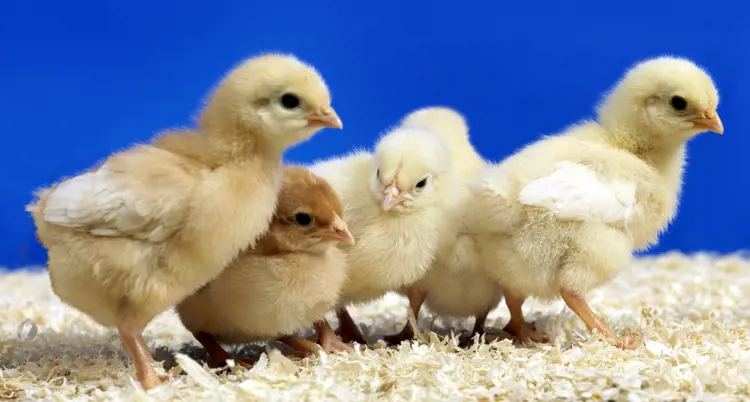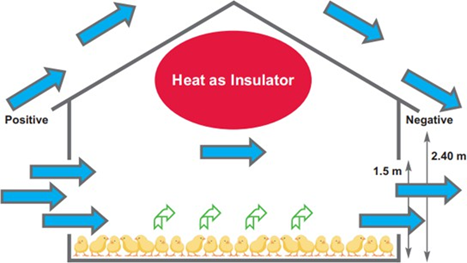Importance of good environmental management
Ventilation is one of the most important, but often mismanaged, aspects of poultry production. Incorrect ventilation at any point during the cycle can negatively affect the performance of the flock. The aim is to keep the birds within their 'thermo-neutral zone', while maintaining optimum air quality and removing excess heat, harmful gases, moisture, and dust from the house environment. In simple terms, a 'thermo-neutral zone' is a uniform, balanced environment where the birds feel most comfortable and will maximize their energy (feed) intake while at the same time using as little energy as possible. Energy will be utilized for bodyweight gain rather than used to produce heat if it is too cold or lost through increased respiration if it is too hot.

The following diagram illustrates the concept of a thermoneutral zone. The temperature range in which the bird feels completely comfortable and does not feel too cool or too warm.

Air velocity, or the speed at which air enters the broiler house, is just one aspect of ventilation that must be managed correctly to ensure that the birds grow in a balanced environment. Incorrect air velocity has a direct impact on bird comfort, and if mismanaged, will create uneven growing conditions.
Management of ventilation is an important tool in managing the internal house environment of the poultry house to achieve the best possible bird performance. At different stages of the bird’s development, the ventilation must be managed carefully to match the requirements of the birds. There must always be a constant supply of fresh air coming into the house and the build-up of carbon dioxide, ammonia, moisture, and dust must be removed from the house. This must be all be done while keeping the temperature felt by all the birds, or the effective temperature, in the house in their ideal comfort zone for their age. The effective temperature is determined by getting the right balance between actual temperature, relative humidity, and air speed. If this is done incorrectly the birds health can be affected, and they will not perform to the maximum genetic potential.

There are two types of ventilation systems that are commonly used in poultry production systems.
- Natural ventilation, or also referred to as curtain ventilation.
- Fan powered ventilation which has three components.
1. Minimum ventilation
2. Transitional ventilation
3. Tunnel ventilation
Natural ventilation:
Natural ventilation relies on opening the house correctly to allow outside air to flow into and through the house. This is usually done by lowering or raising sidewall curtains and hence the name, curtain ventilation. When it gets warm, the curtains are opened to let outside air in, and when it gets cold, they are closed to restrict the flow of air into the house. This method of ventilation is only effective when the outside temperature is close to the target temperature required in the house. As the rate of air exchange depends on the air movement outside.
The system can be managed completely manually, or it can be semi-automated. When there is no automation, the farmer, or the person managing the house, must make decisions on when the curtains should be raised or lowered to maintain a comfortable environment in the house for the birds. This can be done quite well if the person has been well trained, or they have a lot of experience. It does not work so well when the person responsible for make the adjustments is inexperienced or is not there such as during the lunch break or at night.
To overcome some of these limitations, the system can be semi-automated. The system can monitor temperature sensors in the house and can lower or raise the curtains using electric winches when specific set point temperatures are reached.
Normal fluctuations in air temperature and winds during the day (or night) can require frequent
adjustments in curtain settings.
The effectiveness of natural ventilation systems can be improved by installing circulation fans and/or mister or fogging systems. These can also be managed manually, or they can be included into the automation software. On warm, or hot, days with little wind movement outside, circulation fans can be used to increase air movement and provide cooling from the wind-chill effect. The misters can then be brought in as a second level of cooling in combination with the fans to further reduce the temperature felt by the birds.
On cooler days, the circulation fans help to mix the incoming cold air with the warm air in the house to achieve gradual temperature changes. Without the fans, cool / cold, air comes in through the small opening above the curtain, and because this air is denser, it immediately drops down onto the floor. This can cause chilling of the chicks close to the sides of the house and it will result in wet litter. This cold air also displaces warmer air from the house which results in large temperature changes.
Curtain Management Techniques
In open sided houses, correct management of the curtains are key to maintaining a healthy flock status throughout the whole production period by limiting temperature fluctuations. The following points must be kept in mind when managing the curtains.
- Different areas of the house may be experiencing different temperatures resulting in temperature variations.
- Ventilation at all ages is needed to remove excess heat, humidity and CO². During the first week when the house is well sealed it is important to monitor the CO² levels as these can increase due to lower ventilation. The level should never exceed 3,000 ppm. The table on the right gives a guideline of the values that should be achieved to maintain good air quality.
- To prevent wet litter, the development of conditions that could cause respiratory problems or ascites during cold conditions it is important that the curtains are managed correctly.
- Temperature fluctuations, especially at night must be minimised. Good temperature control will improve feed conversion and increase growth rate.
Below are several tips that can be used to achieve good curtain management.
- In the morning, when the outside air is usually cooler, observe which direction the wind is coming from. Open the curtain on the leeward (not windy - the side opposite from which the is coming) side first.
- To improve air exchange and to increase the speed of air entering the house, the curtain on the windward (windy) side should be opened (lowered) by 25% of the opening on the leeward side.
- To lower the house air exchange and slow the air entering the house, the windward side should be open four times (4X) more than it is on the leeward side.
- To achieve maximum air speed over the birds, the curtains should be opened fully (100%) on both sides.
- Up to 14 days of age, the curtains should be opened to provide air exchange in the house, but they must be set to achieve no air speed at chick or floor level. Air movement over the chicks during this period will cause the chicks to be chilled, decreased feed and water consumption and increased energy consumption for heat production. Growth will be reduced.
The illustration below shows the effect of the wind on a house with curtain. Positive pressure develops on the windward side while a negative pressure develops on the leeward side. This causes air to move through the house when the curtains are opened.

Fan-powered ventilation
Fan-powered ventilation uses fans to bring air into and through the house. Powered ventilation generally allows for more control over both the air exchange rate and the airflow-through pattern, depending on the configuration of fans and air inlets, and the type of controller used.
Fan-powered ventilation systems can use either positive or negative pressure. However, most poultry house fan-powered systems now use negative-pressure ventilation. This means that the fans are exhaust fans, pulling air out of the house which creates a partial vacuum (negative pressure) inside the house, causing outside air to be drawn into the house through inlets in the house walls.
1. Minimum Ventilation
Minimum ventilation systems are designed to manage oxygen levels and moisture levels in the house by using fans on a cycle timer. Fresh air is drawn into the house through inlets on the side of the house. These are referred to as side inlets. The graphic below shows how the air enters the house through the side inlets and it is removed from the house by the fans which are also situated on the side of the house. This type of ventilation is also referred to as cross-ventilation.
Minimum ventilation is used to bring in just enough fresh air to exhaust excess moisture and ammonia fumes during cold weather conditions and/or when birds are very small, without chilling them.
The key to successful minimum ventilation is to create sufficient negative pressure in the house so that air comes in at the same speed through all inlets. With air inlets distributed evenly along the whole length of the house, airflow is then uniform throughout the house. It is also important that the cool outside air comes into the house at the right speed so that is mixes with the warm air in the house above the birds (Diagram 1), rather than dropping directly onto the them and chilling the birds (Diagram 2).
2. Transitional Ventilation
Transitional ventilation is a combination of cross-ventilation as described above, and tunnel ventilation. With tunnel ventilation, the air is drawn down the length of the house by large fans. Transitional ventilation happens when the temperature in the house goes above the upper set point where minimum ventilation is not enough to keep the birds in their thermoneutral zone, but the temperature does not go high enough to require the system to change over fully to tunnel ventilation.
In transitional ventilation, more side-inlets will open, and more side fans may come on to bring cool air in and to remove the warm air from the house. If the temperature continues to increase, then as a second stage, a few of the big fans at the end of the house will also come on. This then draws the air gently down the length of the house removing the warmer air and replacing it with cooler air. The number of big fans that come will gradually increase if the temperature continues to get hotter.
Below is an illustration showing the air coming in through the side fans and then being drawn out by the large fans at the end of the house. As with minimum ventilation, cool air comes into the house, and it mixes with the warm air which lowers the temperature in the house. The main difference is that a larger volume of air is being exchanged due to the increased fan capacity. During this phase, the aim is to bring more air into the house to cool it down without it landing directly on the birds.
3. Tunnel Ventilation
As the temperature continues to increase and goes above the next set point, then the system will change to full tunnel ventilation. The side fans will turn off, the side inlets will close and inlets at the end of the house will open and more of the big fans at the opposite end of the house will come on. This will increase the amount of cool air coming into the house. In full tunnel mode with all the fans running, it may possible to get a complete house air exchange in under one minute. This can cause a wind chill effect on the birds as the air moves past them and this will help them to feel cooler.
There is a second stage of cooling that can be brought in if the temperature continues to increase in the house. This is called evaporative cooling. This can be achieved either with in-house foggers/misters or, the more popular system of mounting cooling pads over the air inlets. These
pads are designed to have a thin layer of water running over them while the air is drawn through them by the big fans. As the outside air passes through the wet pads, it is cooled down. The combination of the cooled incoming air and the wind- chill effect can keep the birds in their thermoneutral zone even in very hot weather conditions. The wet pad system does not a lot of management and they do not risk wetting birds or litter.
Summary
The aim of ventilation management is to keep birds within their thermo-neutral zone. If this is not done correctly the flock may be either too cold or too hot. They will not be in their thermoneutral zone. In a cold environment there can be a build-up of harmful gasses and moisture in the house which will negatively affect their health. When the temperatures are too high, they may suffer from heat stress which will negatively affect feed intakes. In both of these situations body weight gains will be lower, mortality can be higher and feed conversion will be poor.
Health, comfortable birds will always perform well. In well ventilated houses, the humidity is lower, there are no cold spots, litter quality is good, and the health of the flock is good.
Contact your local De Heus Specialist to learn more about importance of good environmental management - https://www.deheus.co.za/meet-our-team
